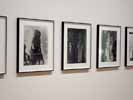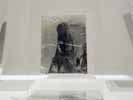thumbnails
(click on images to enlarge)
 15. Jennifer Givogue |
 16. Jennifer Givogue |
 17. Jennifer Givogue |
|
|
 20. "Vinegar" negatives-ROM |
|
| |
||
Damage Done |
2005 • page 3 of 4 |
|---|
thumbnails (click on images to enlarge) |
|
||||||||||||
|
|
works in exhibition |
|
|||||||||||
Artists • Damage Done Jennifer Givogue / the Royal Ontario Museum's "vinegar" negatives In the work of Toronto artist Jennifer Givogue, damage is a state that precedes her intervention. Givogue became acquainted with “vinegar negatives”during an art school field trip to the photo studio of the Royal Ontario Museum. Impelled by the redemptive possibilities of working with previously damaged materials, she later used this material as the basis for her artwork. The self-destruction of a swath of 1960s large-format black-and-white negatives in the Royal Ontario Museum’s archives has created somewhat of a mystery for conservationists, as these acetate-based negatives were produced at least a decade after the last of the infamous, spontaneously combustible cellulose-nitrate negatives of a slightly earlier era. 22 Safety and storage problems with the latter are well known, as they exist in every institutional archive that contains photographic negatives or motion picture film dating from before 1950. The cellulose nitrate base was highly unstable and could burst into flame while being run through a projector or placed in a hot enlarger. Even without causing fires, many of these types of negatives crumpled over time, rendering them unprintable. What the ROM’s negatives have in common with the earlier ones is the telltale stench of acetic acid announcing their decomposition (hence the term “vinegar negatives”). Perhaps most significantly in relation to questions of history, choices must be made as to which of the often overwhelming numbers of vulnerable negatives are to be salvaged and which must be “let go.” Everything cannot be saved due to the sheer volume of material, the slowness of the copying process and the consequent expense.
|
Again, the issue of choice appears as yet another manifestation of the “migratory” dilemma. In this case, it predates by about fifty years the editing challenges that digitization currently creates. Givogue attempts a kind of conservation strategy that is not intended to save the negatives, but to “transform” them by giving them a new photographic form as aesthetic objects. Givogue does so by subjecting a selection of these negatives to a copying process that acknowledges their current physical condition. She places them on a light table to better illuminate the original subject of the negative and also lights them from above so that the marks created by their deterioration are clearly visible. Using a medium-format camera, she photographs these artifacts and re-presents them as 20 x 24-inch black-and-white prints. In so doing, Givogue has proposed another form of “conservation” that invests the aesthetic objects that were once documented by a museum photographer with a “renewed” beauty. However, the new form includes not only traces of the one-time subjects of the vinegar negatives, but also acknowledges a history of photographic technology that has spectacularly failed to meet our desire to “stabilize” our knowledge of the past. 23 It is probably impossible to estimate the numbers of photographs successfully taken but then lost. Givogue’s images offer a subtle critique of the sense of positivism that still seems to drive our faith in image-making technologies; a faith that no amount of disappointment seems able to derail. |
|---|
| back to curatorial projects overview page |
|---|
| back to projects overview page |
| back to home page |